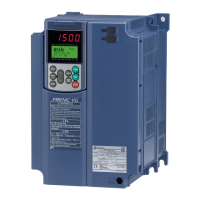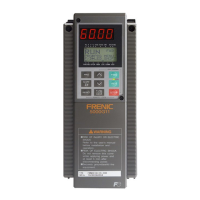5-128
F codes
E codes
C codes
P codes
H codes
A codes
b codes
r codes
J codes
d codes
U codes
y codes
Chap. 5 FUNCTION CODES
Hold: During the power-on sequence, the alarm output is kept OFF (disabled) even when the monitored quantity is
within the alarm range. Once it goes out of the alarm range, and comes into the alarm range again, the alarm is
enabled.
Latch: Once the monitored quantity comes into the alarm range and the alarm is turned ON, the alarm will remain
ON even if it goes out of the alarm range. To release the latch, perform a reset by using the
key or turning
the terminal command
RST ON. Resetting can be done by the same way as resetting an alarm.
Upper level alarm (AH) (J12)
J12 specifies the upper limit of the alarm (AH) in percentage (%) of the feedback amount.
Lower level alarm (AL) (J13)
J13 specifies the lower limit of the alarm (AL) in percentage (%) of the feedback amount.
The value displayed (%) is the ratio of the upper/lower limit to the full scale (10 V or 20 mA) of the feedbac
amount (in the case of a gain of 100%).
Upper level alarm (AH) and lower level alarm (AL) also apply to the following alarms.
How to handle the alarm:
Alarm Description
Select alarm output (J11) Parameter setting
Upper limit (absolute) ON when AH < PV J13 (AL) = 0
Lower limit (absolute) ON when PV < AL
Absolute-value alarm
J12 (AH) = 100%
Upper limit (deviation) ON when SV + AH < PV J13 (AL) = 100%
Lower limit (deviation) ON when PV < SV - AL J12 (AH) = 100%
Upper/lower limit
(deviation)
ON when |SV - PV| > AL
Deviation alarm
J13 (AL) = J12 (AH)
Upper/lower range limit
(deviation)
ON when SV - AL < PV < SV + AL Deviation alarm
Upper/lower range limit
(absolute)
ON when AL < PV < AH Absolute-value alarm
Upper/lower range limit
(deviation)
ON when SV - AL < PV < SV + AH Deviation alarm
A negative logic signal
should be assigned to
PID-ALM.
J15 to J17 PID Control (Stop frequency for slow flowrate, Slow flowrate level stop latency and
Starting frequency)
(Refer to J08.)
J18, J19 PID Control (Upper limit of PID process output, Lower limit of PID process output)
The upper and lower limiters can be specified to the PID output, exclusively used for PID control. The settings are
ignored when PID cancel is enabled and the inverter is operated at the reference frequency previously specified.
(
E01 to E07, data = 20)
PID Control (Upper limit of PID process output) (J18)
J18 specifies the upper limit of the PID processor output limiter in %. If you specify "999," the setting of the frequency
limiter (High) (F15) will serve as the upper limit.
PID Control (Lower limit of PID process output) (J19)
J19 specifies the lower limit of the PID processor output limiter in %. If you specify "999," the setting of the frequency
limiter (Low) (F16) will serve as the lower limit.
J21 Dew Condensation Prevention (Duty)
When the inverter is stopped, dew condensation on the motor can be prevented, by feeding DC power to the motor at
regular intervals to keep the temperature of the motor above a certain level.
Enabling Dew Condensation Prevention
To utilize this feature, you need to assign the terminal command DWP ("Protect motor from dew condensation") to one
of the general-purpose digital input terminals. (
E01 to E07, data = 39)

